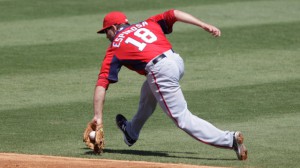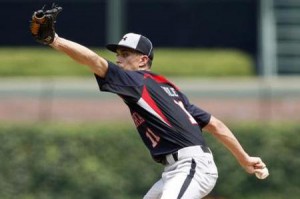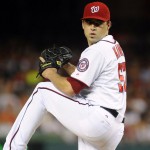Happy Holidays! What a nice surprise; mlb.com Nats beat reporter Bill Ladson posted his first mailbag/inbox column since January 2014. He must have been bored during the holiday lull in baseball news.
As always, since its been like a year since I did one of these, I write my response question by question before reading Ladson’s, and sometimes edit questions for clarity.
Q: Assuming the Nationals don’t make any acquisitions via trade or free agency, what is their in-house solution for second base?
A: Well, in order they’d likely start Danny Espinosa and bat him 8th. And, if the fans’ had their choice, he’d abandon switch hitting, bat righty only and probably have a career resurgence. Just a reminder: Espinosa’s career lefty split is .213/.283/.362 while his career righty split is .271/.343/.460. Espinosa is so good defensively that i’m not entirely opposed to him being the starter; he can spell Ian Desmond at short (in fact, I’ve always thought Espinosa was a better shortstop defensively) and makes up for his awful switch hitting by being so good defensively (but not nearly enough to prevent the team from shopping).
After Espinosa, you have utility guy Kevin Frandsen having stated publicly he wants to be considered for the job. Problem with Frandsen is this; he’s been even WORSE offensively the last two years than Espinosa; he has a .624 OPS in the last two years. I hope there’s not anyone who thinks he’s a better solution. Youngster Wilmer Difo was just added to the 40-man roster, but he’s never played above low-A. That’s basically the roster of middle infielder options on the 40-man roster. Jeff Kobernus played 2B in college but has long since been converted to an outfielder in this organization, so he’s not really an option either. Looking deeper into the minor leagues, there’s some MLFA options at AAA (the likes of DC-native Emmanuel Burriss, current MLFA and Virginia-native Will Rhymes, or maybe even our own long-time org player Jose Lozada), and a couple of Nats draftees who have yet to pan out (Rick Hague and Jason Martinson). But none of these guys are better options than just sticking with Espinosa.
Hence, the reason the team is looking at trade/FA options. There’s a ton of 2B options that are likely available in trade or still on the FA market; its arguable that any of them are better options than just staying the course though. So it wouldn’t surprise me at all if the team stood pat.
Ladson reviews the same three 40-man options and comes to the same conclusions as I do, and says he sees a trade. He likes a trade for Ben Zobrist, like I do, but Tampa is notoriously hard-bargaining. What would we be willing to give up to get Zobrist?
Q: Why are the Nationals willing to trade their best pitcher, Jordan Zimmermann? Wouldn’t Stephen Strasburg get them a better return?
A: I’m sure Strasburg would get a better return; he’s got two years of control instead of just one, and is scheduled to make a third of what Zimmermann will make in 2015. I feel Strasburg is in some ways actually under-rated; despite a pedestrian 14-11 record in 2014, here’s his ranks in the entire majors in some quick categories: 13th in fWAR, 3rd in xFIP, 13th in FIP, 5th in K/9, and 5th in SIERA. Teams are now smarter when it comes to acquiring control; a year of Zimmermann at $16M+ isn’t going to bring back that much anyway (see what the Rays got for David Price, for less money and TWO years of control).
And then there’s this: teams that are trying to win do not trade pitchers like Strasburg. Plain and simple; it would be fan-relations suicide to move Strasburg right now. The team just won the division by 17 games and their closest rival is having a fire sale; why on earth would the Nats look to move someone like Strasburg? So that being said, why are they willing to trade Zimmermann? I think it comes down to several reasons:
1. Money: As i’ve discussed in the past, the Nats payroll was at $135M at the beginning of 2014 and projects to nearly $150M without any subsequent moves. 150M minus Zimmermann’s 16.5M 2015 salary looks an awful lot like the payroll from 2014….
2. Practicality: You don’ t need to win your division by 15 games. You can still win by 5 games and make the playoffs. If the Nats can trim payroll, turn Zimmermann into something that look better than what we may get in a supplemental 1st round pick, AND still win the division in 2015? Wins all around.
Ladson says several things I disagree with; he thinks Zimmermann would bring back a “kings ransom” and he thinks Rizzo is going to “get a deal done” with Zimmermann this off-season.
Q: Given that he’s at an age where he needs to play regularly, does Tyler Moore have a chance of backing up first baseman Ryan Zimmerman in ’15?
A: Not sure what Tyler Moore‘s age has to do with anything; if you’re 22 or 42 you’re going to get ABs in the majors if you can play. To the question at hand; right now i’m projecting Moore to be the 25th guy on the active roster. That doesn’t mean he’ll make it, but he does fill a position of need; right handed power off the bench. Had the Nats not traded Stephen Souza Moore might be a goner. Now? He could still make the team. But somehow I sense that perhaps the team will look to flip him and/or bring in veteran competition for his bench spot. Ladson states the obvious, saying the team will look to trade him since he’s out of options.
Q: Since it appears Michael Taylor is considered the future center fielder, can you see the team holding on to Denard Span beyond ’15?
A: In a word; nope. I’m guessing that Taylor will get some experience as a backup in 2014 (and frankly may get a ton of at-bats, since our outfield isn’t exactly an injury-free haven), and soon the team will have a guy who can play a better CF than Span, hit with more power and run with more speed. All in all, I think Taylor will be an improvement over Span in nearly every category and for 1/20th the cost. Ladson says it depends on how Taylor does.
Q: Last year, the Nationals’ pinch-hitting average was terrible. Any hope it gets better?
A: So far … not really. The bench is still projecting to be basically the same guys as in 2014. Frandsen, Loboton, McLouth and Moore. The only change is the dumping of Scott Hairston for Taylor. But Taylor’s K rate is still high, which means we’ll likely see continued crummy pinch hitting. Ladson points out the Nats havn’t had a good bench since 2012.
Q: How is Lucas Giolito doing? Will he fill a rotation spot if Zimmermann or Doug Fister is traded?
A: Not in 2015. Maybe by mid 2016 if Giolito has a two-level jump this year. Giolito’s best case is to completely shut down high-A in April and force a promotion to AA by mid-season. If that happens, then maybe we’re looking at a mid-April call up in 2016, just in time to replace the potentially departed FAs Zimmermann and/or Fister. But this is a very heady dream; remember; Giolito is still on an innings limit, is still just 20 years of age (he turns 20 in July of 2015), and most pitchers his age are still in college, yet to even be drafted.
If we move Zimmermann or Fister this off-season, then we’re looking at drawing from our AAA rotation for the 5th starter. One of Treinen, Hill, Jordan or Cole. Probably in that order, thanks to 40-man and experience implications.
Ladson is bullish on Giolito; thinks he’ll start in AA and get a call-up in September. That’d be pretty aggressive.
Q: Why didn’t the Nats go after Russell Martin? Their catchers are less than adequate. Is Wilson Ramos still the guy?
A: Disagree here. When healthy Ramos is a beast. Remember he was the frigging opening day 2014 clean-up hitter. The last thing the Nats needed to do was spend millions on someone like Martin. Lobaton is more than adequate of a backup, cost-controlled and we traded a hefty price (Nathan Karns) to acquire him. Ladson agrees with me.


